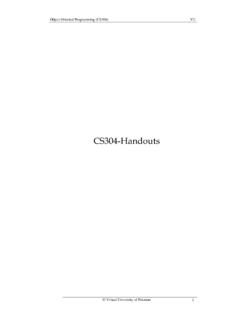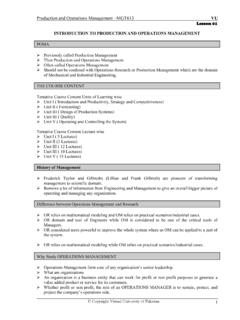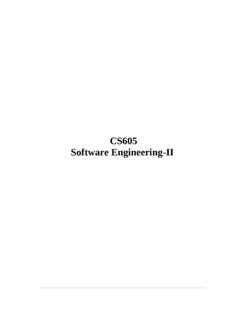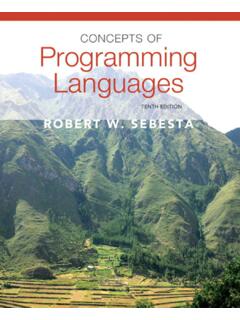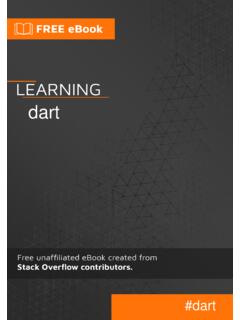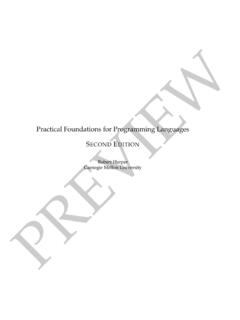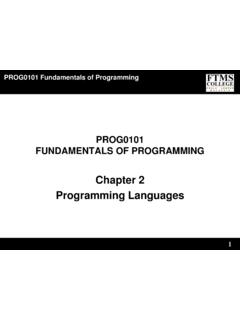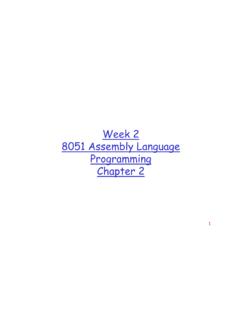Transcription of Concepts of Programming Languages, Eleventh Edition ...
1 GlobAl EdiTioNConcepts of Programming languagesElEVENTH Edition Robert W. Sebestadigital resources for studentsYour new textbook provides 12-month access to digital resources that may include VideoNotes (step-by-step video tutorials on Programming Concepts ), source code, web chapters, quizzes, and more. Refer to the preface in the textbook for a detailed list of the instructions below to register for the Companion Website for Robert Sebesta s Concepts of Programming Languages, Eleventh Edition , Global Go to Click Companion Website3. Click Register and follow the on-screen instructions to create a login name and passwordUse a coin to scratch off the coating and reveal your access code.
2 Do not use a sharp knife or other sharp object as it may damage the the login name and password you created during registration to start using the digital resources that accompany your textbook. Important: This access code can only be used once. This subscription is valid for 12 months upon activation and is not transferable. If the access code has already been revealed it may no longer be technical support go to page intentionally left blankConCepts ofprogramming LanguagesElEvEnth EditionGloBAl EditionThis page intentionally left blankConCepts of Programming LanguagesElEvEnth EditionGloBAl EditionRobeRt W. SebeStaUniversity of Colorado at Colorado SpringsGlobal Edition contributions bySoumen MukherjeeRCC Institute of Information Technologyarup Kumar bhattacharjeeRCC Institute of Information TechnologyBoston Columbus Indianapolis New York San Francisco HobokenAmsterdam Cape Town Dubai London Madrid Milan Munich Paris Montreal TorontoDelhi Mexico City Sao Paulo Sydney Hong Kong Seoul Singapore Taipei TokyoPearson Education LimitedEdinburgh GateHarlowEssex CM20 2 JEEnglandand Associated Companies throughout the worldVisit us on the World Wide Web Pearson Education
3 Limited 2016 The rights of Robert W. Sebesta to be identified as the author of this work have been asserted by him in accordance with the Copyright, Designs and Patents Act adaptation from the United States Edition , entitled Concepts of Programming Languages, 11th Edition , ISBN 978-0-13-394302-3, by Robert W. Sebesta, published by Pearson Education rights reserved. No part of this publication may be reproduced, stored in a retrieval system, or transmitted in any form or by any means, electronic, mechanical, photocopying, recording or otherwise, without either the prior written permission of the publisher or a license permitting restricted copying in the United Kingdom issued by the Copyright Licensing Agency Ltd, Saffron House, 6 10 Kirby Street, London EC 1N trademarks used herein are the property of their respective use of any trademark in this text does not vest in the author or publisher any trademark ownership rights in such trademarks.
4 Nor does the use of such trademarks imply any affiliation with or endorsement of this book by such owners. Many of the designations by manufacturers and sellers to distinguish their products are claimed as trademarks. Where those designations appear in this book, and the publisher was aware of a trademark claim, the designations have been printed in initial caps or all 10: 1-292-10055-9 ISBN 13: 978-1-292-10055-5 British Library Cataloguing-in-Publication DataA catalogue record for this book is available from the British Library10 9 8 7 6 5 4 3 2 1 Typeset in Janson Text LT Std 10/12 by AptaraPrinted and bound by Vivar in MalaysiaEditorial Director: Marcia HortonExecutive Editor: Matt GoldsteinEditorial Assistant: Kelsey LoanesVP of Marketing: Christy LeskoDirector of Field Marketing: Tim GalliganProduct Marketing Manager.
5 Bram van KempenField Marketing Manager: Demetrius HallMarketing Assistant: Jon BryantDirector of Product Management: Erin GreggTeam Lead Product Management: Scott DisannoProgram Manager: Carole SnyderProduction Project Manager: Pavithra Jayapaul, Jouve IndiaProcurement Manager: Mary FischerSenior Specialist, Program Planning and Support: Maura Zaldivar-GarciaAssistant Acquisitions Editor, Global Edition : Aditee AgarwalProject Editor, Global Edition : Amrita NaskarManager, Media Production, Global Edition : Vikram KumarSenior Manufacturing Controller, Production, Global Edition : Trudy KimberCover Designer: Lumina Datamatics , Rights Management: Rachel YoudelmanSenior Project Manager, Rights Management: Timothy NichollsCover Art: Viachaslau Kraskouski/ShutterstockFull-Service Project Management: Mahalatchoumy Saravanan, Jouve IndiaChanges for the Eleventh Edition of Concepts of Programming Languages chapter 6: Deleted the discussions of Ada s subrange types, array initialization, records, union types, pointers, and strong typing chapter 7: Deleted the discussions of Ada operator associativity and mixed-mode expressions chapter 8: Expanded the paragraph on F# selection statements in Section the discussion of the Ada for statement chapter 9.
6 Added three design issues for subprograms in Section the discussions of Ada and Fortran multidimensional parameters chapter 10: Replaced example program Main_2, written in Ada, with an equivalent program written in JavaScript in Section Figure to reflect this new JavaScript example chapter 11: Deleted the discussions of Ada abstract data types, generic procedures, and packagesAdded a new paragraph to Section (Abstract Data Types in Java) chapter 12: Added a paragraph to Section (Inheritance) that discusses access controlExpanded the discussion of class variables in Section a paragraph to Section that discusses final classes in Objective-CReorganized Sections to into a single sectionAdded Table on language design choices to Section a new section, Section 6 (Reflection), including example programs in Java and C# chapter 13: Deleted the discussions of Ada task termination and task priorities chapter 14.
7 Deleted exception handling in AdaAdded a new section, (Exception Handling in Python and Ruby)This page intentionally left blankPrefaceChanges for the Eleventh Edition The goals, overall structure, and approach of this Eleventh Edition of Concepts of Programming Languages remain the same as those of the ten earlier editions. The principal goals are to introduce the fundamental constructs of contemporary Programming languages and to provide the reader with the tools necessary for the critical evaluation of existing and future pro-gramming languages. A secondary goal is to prepare the reader for the study of compiler design, by providing an in-depth discussion of Programming language structures, presenting a formal method of describing syntax, and introducing approaches to lexical and syntactic Eleventh Edition evolved from the tenth through several different kinds of changes.
8 To maintain the currency of the material, much of the dis-cussion of older Programming languages, particularly Ada and Fortran, has been removed. For example, the descriptions of Ada s records, union types, and pointers were removed from chapter 6. Likewise, the description of Ada s for statement was removed from chapter 8 and the discussion of Ada s abstract data types was removed from chapter the other hand, a section on reflection that includes two complete program examples was added to chapter 12, a section on exception handling in Python and Ruby was added to chapter 14, and a table of the design choices of a few common languages for support for object-oriented Programming was added to chapter some cases, material has been moved.
9 For example, Section was moved backward to become the new Section one case, example program MAIN_2 in chapter 10 was rewritten in JavaScript, previously having been written in 12 was substantially revised, with several new paragraphs, two new sections, and numerous other changes to improve Vision This book describes the fundamental Concepts of Programming languages by discussing the design issues of the various language constructs, examining the design choices for these constructs in some of the most common languages, and critically comparing design serious study of Programming languages requires an examination of some related topics, among which are formal methods of describing the syntax and semantics of Programming languages, which are covered in chapter 3.
10 Also, implementation techniques for various language constructs must be con-sidered: Lexical and syntax analysis are discussed in chapter 4, and implemen-tation of subprogram linkage is covered in chapter 10. Implementation of some other language constructs is discussed in various other parts of the following paragraphs outline the contents of the Eleventh Outlines chapter 1 begins with a rationale for studying Programming languages. It then discusses the criteria used for evaluating Programming languages and language constructs. The primary influences on language design, common design trade-offs, and the basic approaches to implementation are also 2 outlines the evolution of the languages that are discussed in this book.


